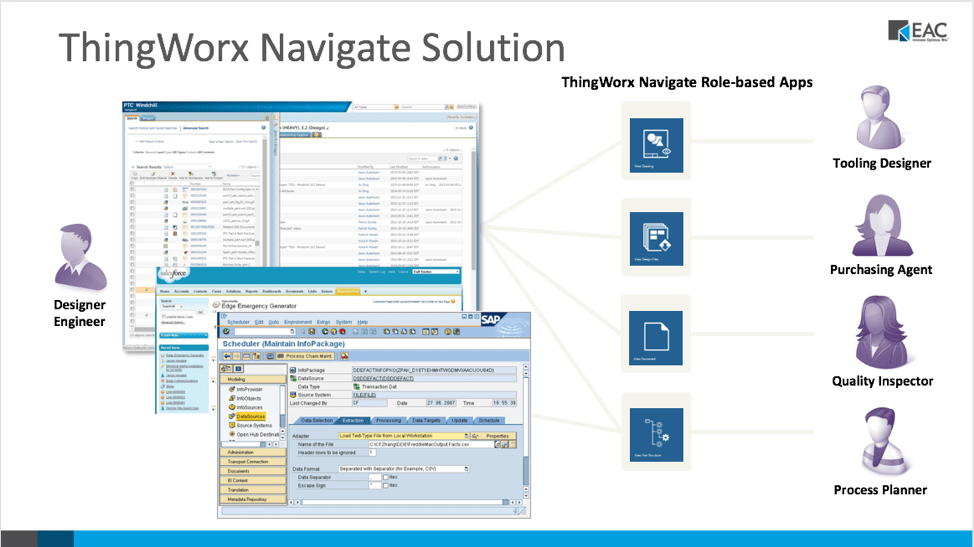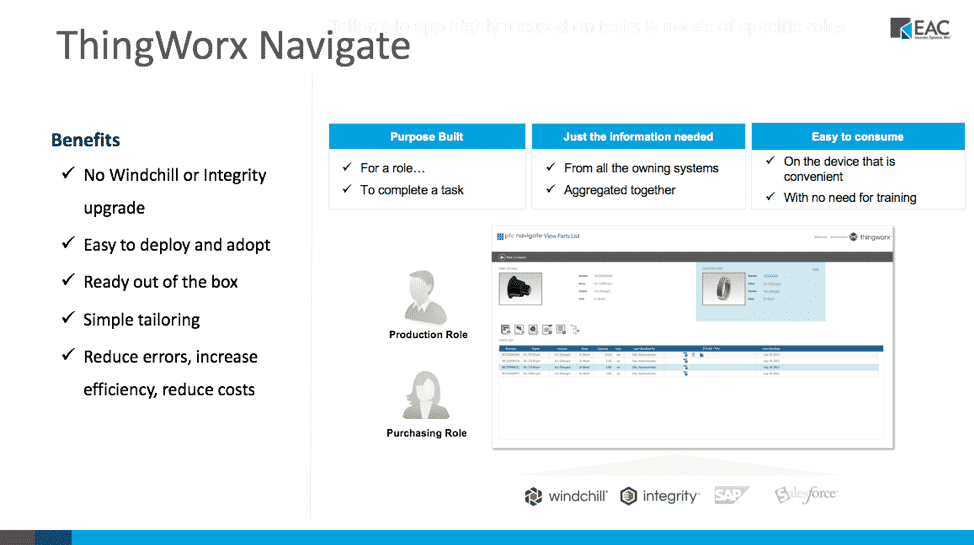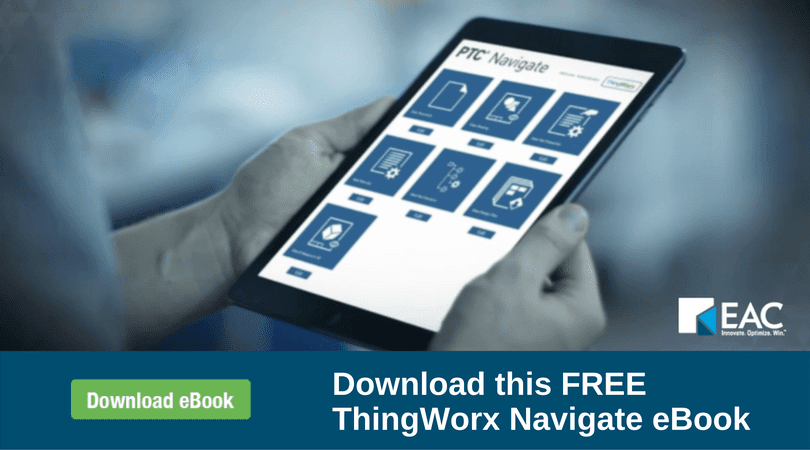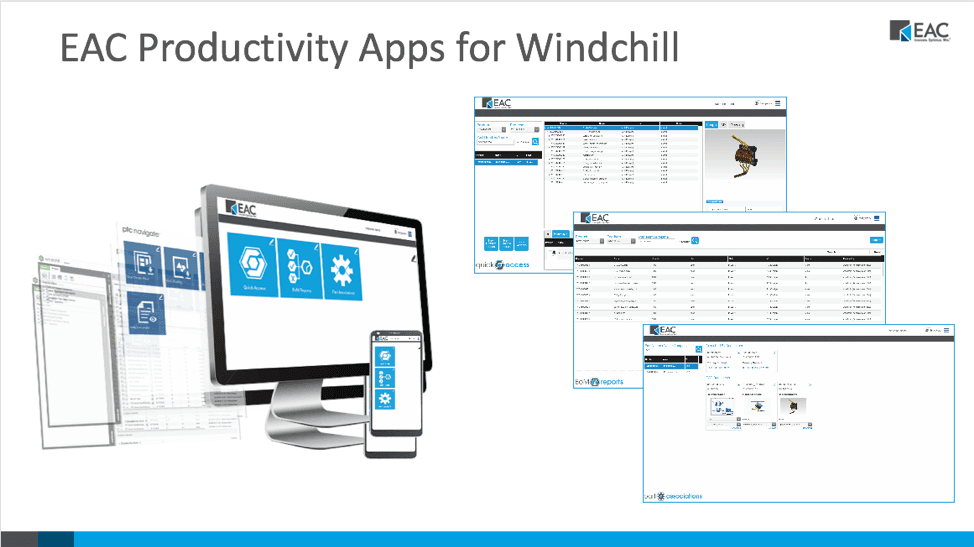- Windchill PDM Essentials
- Windchill PDMLink
- Windchill ProjectLink
- Windchill PartsLink
The future of digital transformation is happening now, and it is driving the future of all industries. This article highlights just about everything you need to know about the impacts and trends involving digital transformation.
No matter where your company resides on its digital journey – or even if you have yet to start with digital transformation, this article is just for you.
What is Digital Transformation?
Digital transformation refers to the concept of applying innovative uses of digital technology to solve traditional business problems.
For example, in a narrower sense digital transformation might refer to a simple concept such as ‘going paperless’. Yet, on a larger scale, it might refer to ‘achieving digital business maturity’.
Digital solutions not only enable organizations to achieve new levels of efficiency through automation, but they also open doors for creativity and innovation (rather than simply enhancing and supporting traditional methods).
Although applying the use of digital technology to solve traditional problems can offer numerous business advantages, many organizations have yet to begin the journey with digital transformation.
Digital Innovation: Where to Start?
With numerous applications, methods, and strategies, it can be difficult to know where to even start with digital transformation!
If this is the case with your organization, – don’t worry, you’re not alone.
According to a research study performed by Accenture and the World Economic Forum, 80% of executives stated they were completely convinced ‘digital’ advancements would fundamentally change and transform their industry within the next 5 years!
That’s right. Eighty percent! … And they’re not wrong at all!
In fact, digital technology has not only already begun to transform industries, but it has also started to transform the way the world experiences products. Despite the ability to recognize the effects that digital processes will bring, only 17% of the studied executives stated they had a strategy in place to address the challenge of digital transformation.
This left a shocking 87% to admit they had no current digital strategy in place whatsoever! This is exactly why, if you have not yet started your digital transformation journey, it’s important to realize A) It’s not too late and B) You are not alone. There is no better time to start than now!
Organizations are realizing the significant impacts that the digital transformation era brings and how it’s going to drastically change just about everything when it comes to the way we do business.
The Impact of Digital Transformation
The process of digital transformation is creating entirely new ways of doing business. It has begun to create new experiences for customers while adding entirely redefined value propositions for mature product segments.
This era of digital transformation has started to impact and define what products are and what they mean to businesses and consumers.
Product perceptions are changing
Digital trends have also started to influence purchase decisions and sales processes. As the digital world has advanced, the average consumer is making purchase decisions with a Product as a Service (PaaS) mindset.
This means the rise of digital transformation has driven consumers to be sold by the outcome of the product – the recurring value. Manufacturers can address this shift in the market demand archetype by embracing three technology categories – Internet of Things (IoT), analytics, and mobile.
The future and advancement of technology is happening now
Established power plays and industry lines are beginning to blur. You cannot wait until some time in the near future to start your digital journey.
If your organization is going to succeed going forward, you won’t want to be left behind in this new industrial revolution, or you will fail.
Whether or not you’ve noticed if your industry has been affected yet, the key message is the effect of these disruptive technologies doesn’t discriminate one sector or industry. Every industry will see a major impact due to these digital technology advancements… And it is happening right now.
‘Business as usual’ is no longer an option. Organizations must adapt in order to survive.
The future of Digital Transformation: Smart, Connected Products
Digital transformation is reinventing products. Products from cars, to jet engines, to pumps, to heavy equipment, to medication, and more!
Machines, assets, and devices are starting to communicate, learn, and react to newly accessible context as they exchange and leverage data from sensors.
We are talking about the area of ‘living products’ – meaning transformative products that are responsive, collaborative, reactive, and responsible. Whether products are B2B or B2C, there will be a totally different process in the way we think about how our customers are using our products in the near future.
The future is now. Don’t let the opportunity slip away.
The first step in your digital transformation journey should be a strategic one. Understand where you are, where you want to be according to your current framework or understanding, and where you’d like to be as you embrace future technology and evolve with changing markets and new opportunities.
EAC Product Development Solutions would like to help you begin your transformation. We provide the people, technology, and services to make any transformation successful. The first step should be a Product Development System Assessment (PDSA). This will help you understand the opportunity that lies in front of you. Request more information on the PDSA today and start taking your digital transformation seriously.
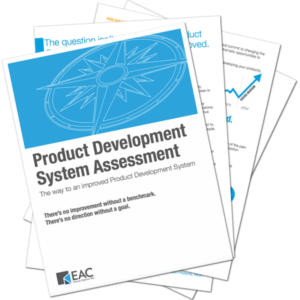
Our Product Development System Assessment will help you start your digital transformation journey
You’re likely to have experience with Bill of Materials (BoMs) if the nature of your business has anything to do with product development.
Let’s talk about why bill of materials are so important, how BoMs impact business, and the best BoM management practices. Or check out another helpful article on BoM management, “How BoM Management plays a role in your PLM processes“.
The importance of bill of materials
BoMs define products as they are designed (CAD or engineering bill of materials), as they are ordered (sales bill of materials), as they are built (manufacturing bill of materials), and as they are maintained (service bill of materials).
They incorporate product information from design and engineering, document control, operations, manufacturing, purchasing, contract manufacturers, and more. Bill of materials influence inventory levels, material purchases, shop floor assemblies, and so much more.
In fact, departments often rely on BOM records to get the job done right. Whether you realize it or not, your BoMs drive and affect your businesses’ operational success. This is why it is so important that your organization creates and manages well-organized, correct and up-to-date bill of materials.
BoM information accuracy and why it matters
BoMs require complete and accurate information, in order to successfully benefit design, manufacturing, sales and service building quality products.
The accuracy of BOMs influences an organization’s ability to make well-rounded product development decisions. These decisions fundamentally impact the efforts organizations peruse to generate a product in the most efficient, cost-effective way.
Oftentimes creating BOMs requires input from design, procurement, manufacturing, and sales. Using manual methods to collect and enter items on various BoMs increases the risk of producing inaccurate, out-of-date, or even possibly duplicate BoM versions.
Furthermore, if departments produce products based on incorrect or inaccurate bills of materials, delays to market can occur. This can not only be very costly for an organization, but it oftentimes impacts an entire supply chain.
Inaccurate bills of materials are one of the costliest errors engineering companies can make. In order to avoid the risks of inaccurate BoMs, many organizations have started to reevaluate the way they create, manage, and share product information.
BoM management processes
Bills of materials (such as eBoMs, sBOMs, mBoMs) are most-likely part of your product development process. That being said, what are your current processes for managing those BoMs?
How do you share, collaborate, and ensure the accuracy of your organizations’ bills of materials? Do you find it difficult to manage the differences between them and keep the data consistent across eBOM (engineering bill of materials) and mBoMs (manufacturing bill of materials)?
Odds are if you have yet to implement technology solutions to manage your bills of materials, your methods for BoM management most likely involve spreadsheets, emails, rekeying information, and multiple other systems of communication.
If this is the case, don’t worry – you’re not alone. Studies show nearly 50% of product development companies still use spreadsheets (or sometimes even nothing at all) to manage complex bill of materials!
Despite the big workload that BoM management represents, many organizations are still comparing bills of materials in excel spreadsheets or by opening separate BoMs and manually connecting the dots. This management approach is not only tiring, but it also increases risks of human error and mistakes, especially if the bills of materials are very long.
In fact, is not unusual to find one giant excel spreadsheet on top of information managed by PLM (product lifecycle management), ERP (enterprise resource planning), CRM (customer relationship management) and other databases. Why is that? The information required to assemble bill of material documents tends to reside within separate, disconnected enterprise systems.
It’s time to change that.
Connecting business systems and information
In a world of complex, role and department-specific enterprise systems, productivity can seem quite limited. But the truth is, with the help of technology, businesses no longer need to operate this way. Collaborative solutions exist, and they really are as simple to implement as they, well… should be.
System integration tools (such as applications) change the way organizations create, manage, and share product information- without even having to upgrade or change current enterprise systems.
Using system API connections, applications can pull data from disconnected enterprise systems and consolidate it into centralized dashboard display windows. In fact, many integration applications are even ready to go straight out-of-the-box (yes, this means they require absolutely no special configurations or complicated implementation at all).
For instance, productivity apps offer simple, role-based access to data and other enterprise systems making it easier for stakeholders to view and understand consolidated product information and data. What makes simple applications that integrate enterprise data even better is the fact that most of these system collaboration tools are even affordable.
With a single view to into multiple enterprise systems (such as ALM, MRP, ERP, SLM, CRM, Accounting, and PLM) you can be sure that users have access to the latest and most accurate product information when they need it, and how they need it. There’s really no catch. Productivity apps really are solutions that are; easy, affordable, and that solve the complexity of dealing with multiple disconnected enterprise systems.
Effective BoM management & bill of materials software
Parallel to system integration apps that can pull and consolidate enterprise data, BoM applications can also automatically consolidate real-time data across enterprise systems.
This means organizations can enable real-time BoM collaboration – and that is a game changer.
Real-time BoM collaboration empowers users with capabilities to collaborate and work together creating a bill, sharing BoMs and associated data, and even preview CAD drawings and images. It also opens up the ability to simultaneously edit manufacturing bill of materials, while completely avoiding duplicate and inaccurate documents. This enables users to get a virtual ‘live view’ of data.
Users are able to maintain and manage all associated product documentation such as part datasheets, materials required, CAD drawings and files, as well as anything else that is needed to manufacture a product all in one centralized location. This reassures one sole accurate and revision-controlled bill of material for a product.
This is exactly why it is so important to establish systems and methods that enable all departments within your product development process to be able to share, collaborate, and ensure the accuracy of your bills of materials.
A simple bill of materials software
Our experts at EAC Product Development Solutions recognized the need for better BoM management within many organizations- That’s why we created our bill of materials software application, BoM Reports.
Our BoM Reports PLM application is essentially an out-of-the-box PLM system plugin. It’s easy to use, simple to integrate, and an extremely affordable for any organization.
We designed our Bill of Materials Reports application with the intention of making manufacturing bill of materials and engineering bill of materials management ‘easy’ for organizations of all sizes. Meaning- our bill of materials software can even work for small businesses!
Our BoM Reports app delivers access to your accurate bill of materials database while it provides visual representations, cost rollup for materials, and detailed informational listings of items within bill of materials.
We guarantee our BoM Reports application will enhance your bill of materials management. In fact, it has changed the way many of our customers do business.
Our EAC Productivity app enables purchasers to see product cost roll-ups during design, so they can hit cost targets. It allows project managers to see the highest level status and availability of constituent parts so they can keep projects on time and budget. It helps fabricators see what version of parts go into the build so they can prevent scrap and rework- and SO much more!
We’re excited about how our organization is enhancing product development and we would love to share more information with you about how our EAC productivity apps really work.
If you would like more information about apps that could work for your business insert your information below. We promise not to fill up your inbox with overloads of information, we simply want to share tips, tricks, and tools that will help your organization succeed.
These days product data is everywhere. Everyone seems to collect it, have a lot of it, but the question remains; how exactly can you ensure your organization’s product data is being put to good use?
It’s time to take your product development one step further by providing role-based data access, connecting your enterprise systems, and learning how to make the most of your product data. I am going to explain exactly how easy that is to do.
The current state of product data
Companies today have many different roles that require access to product data. This may include people outside of the typical roles of which you may be thinking.
Departments such as engineering, manufacturing, that’s a given, but expand your thinking to include operations, purchasing, and marketing. They all need data access in order to edit and consume information. Think about sourcing…I’ll stop there, but you get the idea.
Let’s focus on the engineering department for a moment.
People could be involved from the mechanical side, the electrical side, or even a quality standpoint. Beyond that, people need to either contribute or consume information that could include manufacturing, service, sales, and more.
Product data game-changers
Product data silos limit productivity – PTC & EAC have the answer.
PTC ThingWorx Navigate was designed to address data accessibility problems by providing simple role-based apps that deliver just the right information to different groups (or departments) in the way that they need
When non-engineering colleagues need access to vital information, they typically interrupt an engineer or designer with a request. ThingWorx Navigate eliminates that distraction and “double-billing.” Through role or task-based self-service applications, data can be securely shared with a team. That way non-expert teams can use a simplified user interface to access the product data they need, right when they need it.
To help accelerate product development processes and take product data even further, our company (EAC Product Development Solutions) has also created what we call EAC Productivity Apps that work alongside ThingWorx Navigate apps.
So what’s the difference between ThingWorx, ThingWorx Navigate and our EAC Productivity apps?
This is a great question- I am going to try and paint the picture for you.
First, it’s important that you understand what ThingWorx is and how it is different from ThingWorx Navigate.
ThingWorx is the proper name of PTC’s Internet of Things (IoT) platform comprised of 5 components; foundation, industrial connectivity, analytics, studio,
The foundation component is the heart of the ThingWorx loT platform used to make connections to ‘things’ which could be machines, products or software systems or pretty much anything with an IP address and a communications interface.
User interfaces to the data coming from these connections are displayed on websites called ‘mashups,’ created with ThingWorx foundation. You might know these perhaps as ‘data mashups’ or possibly as ‘data dashboards’. Simply put, Thingworx is the IoT platform that makes everything possible. (Here’s exactly what makes Thingworx the leading technology for industrial IoT)
Then you have ThingWorx Navigate.
ThingWorx Navigate is the proper name of PTC’s applications that
ThingWorx Navigate Apps use a Windchill (PLM) connector to extract product data for presentation to Windchill Product Lifecycle Management users.
Fundamentally, ThingWorx Navigate Apps are all simply data and product information mashups created with ThingWorx. With ThingWorx Navigate you receive out-of-the-box apps that are instantly ready to be used with your PLM system. The idea behind these product lifecycle management apps is to ensure users can capture the complete functionality of their PLM (product lifecycle management) investment.
ThingWorx Navigate PLM Apps include:
View Design Files – A design file would be a format of a file that isn’t the native CAD format. This could be a staph or Induce or perhaps a 3D PDF
View Drawing – Allows you to look at just drawings. This application pulls drawings from your Windchill PLM system.
View Part Properties – This feature allows you to look at part properties- as if you were hitting the ‘Information button’ next to a file.
View Parts List – Allows you to look at bills of Materials (BOMs)
View Part Structure– With the View Part Structure App, ThingWorx is actually going into PDMLink and showing different aspects of a specific part instead of different ways of going at it (such as having to open several different tabs to get information). Using this application, you can get all your information together on one page. This feature also includes capabilities that cross-highlight part structures within your product. For instance, you could select a component and it would highlight that part and create a hyperlink that allows you to directly look at that specific part. This feature essentially creates a mash-up that takes information from different places inside of Windchill PDMLink and brings them together putting them on one screen, allowing you to have all your information at your fingertips.
View Document & View Document Structure
If you would like to learn more about ThingWorx Navigate technology or if you have any questions, you can always request to talk with Thingworx Navigate specialists here.
PLM Applications created by EAC
Our EAC Productivity Apps (also known as product lifecycle applications)
They allow departments to access content and perform common tasks through a very simple interface, versus having to use a complex product lifecycle management system (PLM) or Enterprise Resource Planning (ERP) system.
PTC Navigate Apps vs. EAC Productivity Apps
Our EAC Productivity Apps provide capabilities beyond that of the out of the box ThingWorx Navigate apps.
In short, ThingWorx Navigate applications allow you to securely access and present role-specific data from your Windchill system. They provide all of the power of a Product Lifecycle Management (PLM) system to someone who is not familiar with its ins-and-outs of product data management.
EAC Productivity Apps take it a step further by taking the underlying technology of ThingWorx Navigate, and the ability to get at the information in the PLM system and create even more complete applications that really give individuals instantaneous access to the information and product data they need to do their job. EAC’s PLM applications are created using PTC’s ThingWorx IoT platform, however, they can run independently of ThingWorx Navigate.
These apps are unique to EAC.
While built using the same ThingWorx foundation, ADK and [Windchill connector], they have their own look, feel and functionality. These mashups are packaged and sold together as a collection. EAC Productivity Apps created for Windchill promote user adoption and amplify the return on the investment you’ve made in your Windchill system, as well as extending role-based visibility into relevant product data and the impact PLM has on your organization.
Take your product data further with EAC Productivity Apps
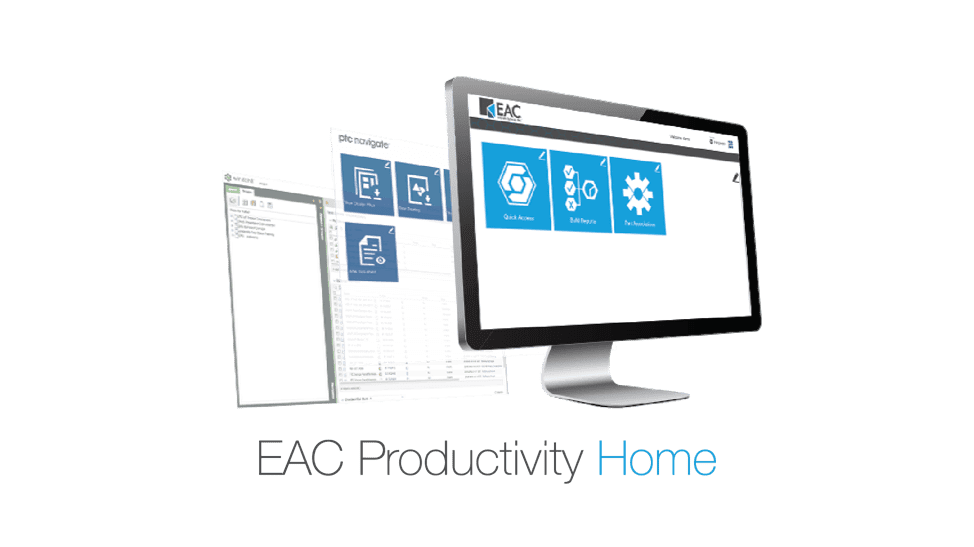
Every subscription of EAC Productivity Apps includes free access to EAC Productivity Home. EAC Productivity Home is a proprietary framework, or launcher, for ThingWorx Navigate applications.
It sits on top of Windchill and
The EAC Productivity App, Quick Search, provides a simple way for users to find content in Windchill. It removes the need for users to apply an understanding of how Windchill objects are related in order to find the information needed to do their job.
The Quick Search PLM application also allows users to search for components and retrieve information and file formats. For instance, if you were to grab a drive system and do a quick search, it’s going to find product information such as parts, EMP like documents, CAD files and more. See EAC Productivity Application Quick Search in action here.
You can also learn more about the Quick Search features in this brochure.
The Quick Access EAC Productivity Application streamlines access to critical and select data sets. Simplifies downstream users feeding critical quality information back to engineering with minimal effort.
This EAC Productivity App allows downstream users to feed critical quality information back to engineering with minimal effort. The simplified interface and consolidated task workflows help users easily submit new problem reports, new change requests, and new variances.
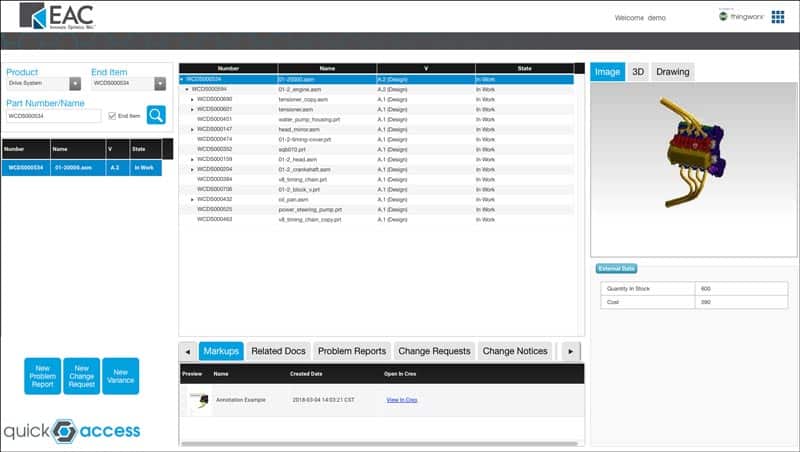
For instance, you could select a component (such as a product), pick its name (the end item number), search for it, and you would get straight to assemblies. With the use of Quick Access users can easily submit new problem reports, change requests, variances and more.
You can learn more about Quick Access features in this brochure.
The Part Associations EAC application provides a “shortcut” for non-CAD users to access critical files and documentation associated with designs like drawings, parts, assemblies, and other documents associated with CAD files and part data.
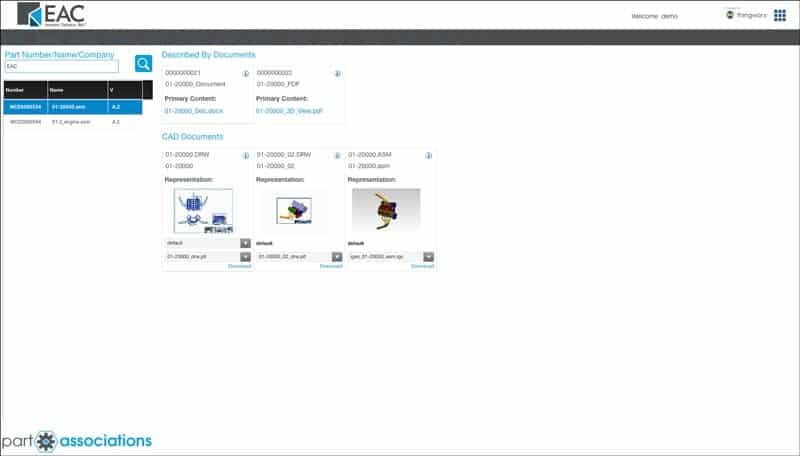
You can learn more about Part Association features in this brochure.
BoM Reports App provides a visual representation of cost
This EAC Productivity App allows users to quickly assess a Bill of Material and ensure projects stay on-time and on-track. The simplified view helps ensure products are built with the appropriate design iterations. With the use of BoM Reports users can easily see BoMs, lists of unreleased parts, parts that have been created or modified by specific users and more.
This app allows users to see the progress of a bill of materials, and apply filters to focus on parts that are not yet released. It is also useful for viewing all of the “make” parts or “buy” parts in a given BoM, or all parts created/modified by a particular user.
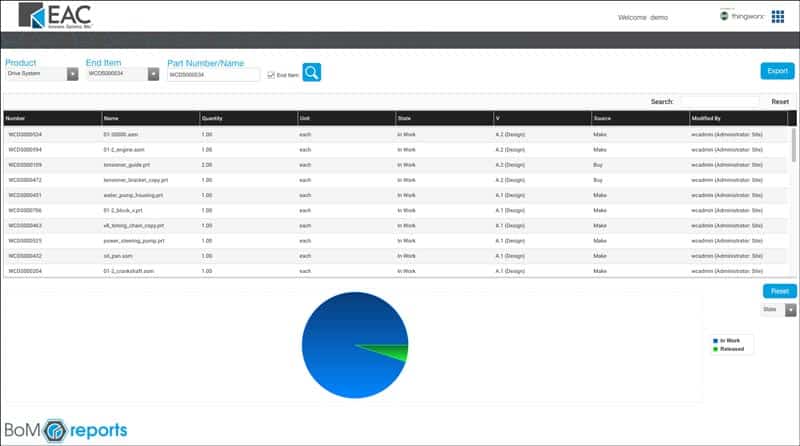
Get better access to your product data
See all the features of EAC P
Imagine if you could manage quality, reliability, and risk at every stage of your product’s life cycle. You could reduce costs, speed innovation, and enhance next generation products. PTC’s product lifecycle management (PLM) software, Windchill, lets you do just that.
Want to see an example of how Windchill software is used? See how Virnig Manufacturing uses PTC Windchill to change the way their data is delivered within their organization.
Already using Windchill and need help with admin and support? You’ll want to check out our Alliance Program, provided to our customers for on-going technical support, business process consulting, and mentoring services on a monthly basis.
Already using Windchill but you or some of your team member don’t use it often, therefore, it gets confusing? You’ll want to check out our role-based apps for casual Windchill users – EAC Productivity Apps or ThingWorx Navigate will help you.
Don’t know what the heck PTC Windchill is? Then read on.
What is PTC Windchill?
PTC Windchill is a product lifecycle management (PLM) application suite that leverages a consolidated view of product information through multi-system data. It’s a systemic enterprise wide approach to maintaining product and process quality throughout the entire product lifecycle.
PTC Windchill PLM software provides a complete functionality dimension to help organizations capture product structures from computer-aided design tools, transform them into full engineering bill of materials (eBoMS), to manufacturing bill of materials (mBoMS), to service bill of materials (sBoMS) all while retaining the linkages between different perspectives on the product. Windchill solutions break down organizational barriers, allowing teams to work faster and more accurately all while reducing time-to-market and cutting costs.
The Windchill Product Lifecycle Management system can help streamline your product development and service information processes. It’s a system that can help your organization create better products, with more variations, faster, at a lower cost. As a manufacturer, your pressures are not only continual – they’re mounting. Your industry is changing. Your customers’ requirements are evolving. And your supply chain is constantly adjusting to
Windchill helps with exactly that. As an integral component of PTC ’s Product Development System, Windchill manages all product content and business processes throughout the product and service lifecycle. And it has a robust, high-performing architecture to help you today – and to prepare you for tomorrow’s uncertainties. Windchill provides a rich systematic approach for creating, configuring, managing and reusing product structures and associated content, such as CAD files, documentation, requirements, manufacturing information, service information, part/supplier data, calculations and illustrations.
Windchill can also play an important role in increasing your company’s competitiveness by allowing continuous improvements and automation of business processes and procedures. Windchill is an
PTC Windchill Cost
PTC Windchill made updates to their PLM packaging and pricing – which means you can customize dashboards and product data more than ever before at a cost that makes sense for your organization. Here is a breakdown of the new PLM structure.
PTC Windchill Certification
Once you’re ready to purchase the software, you’ll need to make sure it’s learned and understood in a timely manner and without frustration. We have a few options:
Short-Term Support: EAC’s Product Development System Services Team has a long track record of successfully implementing Windchill products.
Long-Term Support: Check out our Alliance Program – EAC’s PTC Windchill system administration and support services for on-going technical support.
Support at your own pace: Your team can get PTC Windchill certified by taking our classes we offer for end users and managers. Check out our training schedule.
The Windchill Products Explained:
Windchill products are application modules that offer users specific sets of features and capabilities within the Windchill application suite. Some of the most common Windchill PLM modules include:
What is Windchill PDM Essentials?
PTC Windchill Product Data Management (PDM) Essentials is built on PTC’s production proven PTC Windchill software.
Windchill PDM Essentials simplifies data management activities by transparently incorporating them into the design process. It manages all forms of information such as CAD drawings, customer requirements, schematics and Bill of Materials (BoMs) that are generated during product development.
This modern product data management solution makes it easy to manage, share, and review your data. It’s finally possible to have a single view of the latest product data, along with tighter integration to major end CAD vendors, Microsoft Office, and desktop tools. Plus, it allows your users to save time with better version control, automated data release, and simple search capabilities. Learn more by reading the PTC Windchill PDM Essentials Data Sheet.
What is Windchill PDMLink?
With an abundance of data dispersed throughout your organization, how do you maintain the integrity of your product information when multiple people are working on the same files? The solution is easy – Windchill PDMLink.
Windchill PDMLink is a Web-based, industry-proven Product Data Management (PDM) system that supports geographically dispersed teams while managing critical processes such as content, change and configuration management. Windchill PDMLink maintains the integrity of your product information by storing master data in a secure area where you can control, monitor, and record all changes.
When a change is made to your data, Windchill PDMLink stores a modified copy of the data, signed and dated, in a secure area alongside the old data, which remains in its original form as a permanent record. In addition to providing change control management, Windchill PDMLink enables you to manage your product’s release cycle as well as its configuration. Check out the PTC Windchill PDMLink Data Sheet for more information.
What is Windchill ProjectLink?
Windchill ProjectLink is a collaborative product development web-based environment that automates and tracks projects.
ProjectLink provides a common workspace where you and your team can share and discuss documents and product structures, hold meetings, and communicate and track progress on tasks. From private exchange environments to public business to business (B2B) exchanges, ProjectLink is a secure web-based system that can easily be used in any collaboration environment.
It can also be used well beyond the engineering and manufacturing departments of your organization. Any project that requires team members to share electronic information such as writing annual reports to
What is Windchill Partslink?
Windchill PartsLink is a module for PDMLink that adds part classification-based features.
PartsLink enables you to perform parametric attribute searching and manage your results through convenient navigation and searching. You can search parts by typing a free-form product description or a part number in the search criteria text box. You can browse the hierarchically organized structure of your parts using text and images. You can also refine your search by constraining parameters in a parametric search.
Windchill PartsLink enables your team to perform similar part searches, expanding your search to look for matching parts that have parametric attributes that are within a certain percentage or absolute tolerance of the selected part. Additionally, you can export the result set to a file.
Many companies lack a comprehensive part search system and as a result they lose the benefits of reusing product components. Criteria-based searching limits the result set, which helps a great deal in reuse decisions. PTC Windchill PartsLink helps solve that problem.
What is Windchill Quality Solutions?
Depending on your specific Windchill Quality Solutions suite (Windchill Quality Solutions 10.1 Desktop, Windchill Quality Solutions 10.1 Administrator, Windchill Quality Solutions 10.1 Web Access) you may have access to one or more applications.
Windchill Quality Solutions, the desktop version, is the cornerstone of the Windchill Quality Solutions suite. It is available in both the team and enterprise additions and is the feature rich windows application for all of your reliability and maintainability activities.
Available in the enterprise addition you will also find Windchill Quality Solutions Administrator which provides you options for administrative controls including options to support secure login.
Windchill Quality Solutions Web Access available specifically for Windchill FMEA infractions in the enterprise edition, allows you access for data entry, filtering, graphing, reporting and more.
Is there other Windchill Software for product data management and process management?
- Windchill MPMLink acts as an integral solution for Manufacturing Process Management.
- Windchill FlexPLM is a product lifecycle management solution that is widely used for retail, footwear & apparel and consumer product companies.
- Windchill Requirements Management is a combination of PTC’s Integrity product and Windchill PDMLink that manages product data software and hardware requirements.
- Windchill PPMLink is a program that provides portfolio management capabilities to discrete manufacturers.
- Windchill Service Information Manager creates associative, interactive service parts information used throughout a product’s serviceable lifecycle.
- Windchill Service Parts improves service operations by enabling service information to be organized and optimized for accuracy, applicability, and rich, graphics-driven delivery.
Want to see a PTC Windchill tutorial to see the software in action? Watch this on-demand video of Windchill’s basic software capabilities.
Creo, the shorthand name for Creo Parametric, (formerly known as Pro Engineer) is a powerful and intuitive 3D CAD software optimized to address the challenges organizations face as they design, analyze, and share information with downstream partners.
Developed by PTC, the original pioneers of parametric CAD, Creo is a powerful foundational software supporting an integrated family of product design tools used by thousands of manufacturers worldwide.
The Creo family of design applications, modules, and extension speak a common language, meet the needs of different stakeholders, and truly combine parametric and direct modeling techniques. Creo helps build bridges instead of barriers between you, your ideas, your teammates, your partners, and your customers.
Creo Parametric 3D CAD software can easily be customized and extended through the addition of modules and extensions, but the product family also contains stand-alone purpose build design applications such as Creo Simulate, Creo Direct, Creo Layout & Creo Options Modeler. Each stand-alone app serves a different purpose in the product development process.
From concept to design to analysis, to effectively sharing your information with downstream partners (such as manufacturing and technical publications), Creo is a rock-solid foundation for any design group. It supports the needs of modern manufacturing and product development organizations.
What makes Creo Parametric such a powerful product design and development tool in your company’s quest for a competitive advantage?
There are many unique aspects of the innovative Creo product family – Here are my top 4.
Flexibility
For designers who are involved in multiple phases of the product development process, PTC Creo provides scalable access to the right capabilities. Subscription licensing enables to adjust and right-size their software over time.
For those involved in specific aspects of the product development process, there are apps tailored to meet individual needs. Regardless of your role in the product development process, you can use the right tool at the right time.
Interoperability
All of the products in the PTC Creo family speak the same language. Because of this common language, your data flows seamlessly between different apps. This means no more recreating work as you move through the design process and no more walls to throw your data over.
Combined benefits of both parametric and direct modeling
PTC Creo integrates the power of both 3D CAD modeling approaches into a single system, so you get the power and control of parametric modeling combined with the speed and flexibility that’s only available through direct modeling.
Multi-cad Data Handling
PTC Creo includes an incredible convince ability to work with and edit data from any CAD source. This means no recreating designs because of incompatible data, and no need to ask your partners or customers to change CAD software systems.
Want to learn more about what PTC Creo Parametric 3d CAD software can do for you? Download the Creo Parametric Datasheet or contact us to talk with a technology specialist today!
Looking to make some major advances in innovation and digital transformation at your company? Check out how PTC Creo is the leading 3D CAD software in the industry.
I’ll start off explaining to you what exactly PTC Creo Parametric is and what it does for your design process.
What is PTC Creo Parametric?
PTC developed a premium parametric and direct computer-aided design (CAD) modeling software called Pro/ENGINEER. Pro/E was rebranded into PTC Creo Parametric and is now the leading product design software in the product development industry. Over 12,000 manufacturing companies worldwide use PTC Creo (Pro/E) software.
PTC Creo software gives you the ability to work with and edit data from almost any CAD source without recreating designs due to incompatible data. Creo provides a robust and scalable 3D CAD product design toolset for all different skill-levels of engineers and designers. With Creo CAD software you can quickly create 3D models of any part or assembly and improve existing designs with comprehensive surfacing capabilities.
PTC Creo Parametric provides 3D capabilities such as:
- 3D Part & Assembly Design
- Automatic 2D Drawing Creation
- Parametric & Freestyle Surfacing
- Assembly Management & Performance
- Sheet Metal Design
- Mechanism Design
- Plastic Part Design
- Direct Modeling (Flexible Modeling)
- Additive & Subtractive Manufacturing
- Augmented Reality
- Multi-CAD
- Collaboration
- Piping & Cabling
- Rendering
- Design Exploration
- Fastener Design
- Advanced Framework Design
- Legacy Data Migration
- Human Factors Design
- Core Simulation Capabilities
How to Download PTC Creo
“I’m already using another CAD software. How do I know PTC Creo is right for me?” Chances are you like to ride the bike before you buy it, right? That’s why PTC allows you to try it out before you decide to purchase. Download a free 30-day trial of PTC Creo here.
PTC Creo Parametric Software is constantly improving
Every version of Creo is better than the last! For instance, when Creo 4.0 was released it included capabilities for additive manufacturing, model-based definition (MBD), and smart connected design that allows engineers to leverage 3D modeling to define individual components and product assemblies. With Creo 5.0 building on the previous release, it contains all of Creo 4.0’s functionality and more!
The Intelligent Mini Toolbar: the mini-toolbar gives you access to relevant options while staying focused on the graphics area.
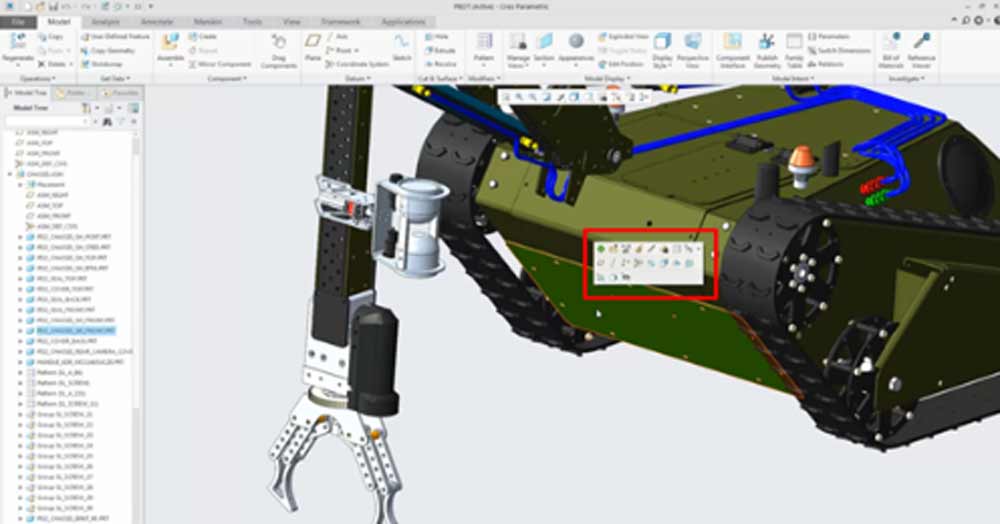
Customizable Menus: you can now tailor the tool for optimal productivity to customize your own workflow.
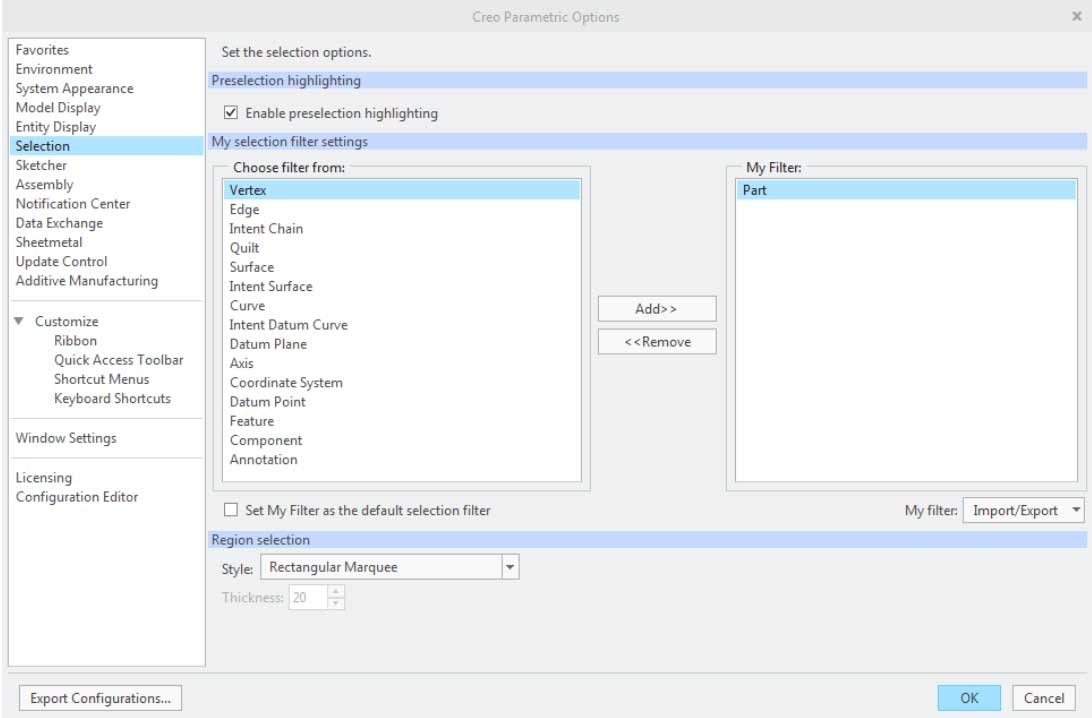
Flexible Modeling for Sheet Metal: you can now edit sheet metal bends, bend reliefs, corner reliefs, corner seams, and forms – simplifying designs for faster analysis.
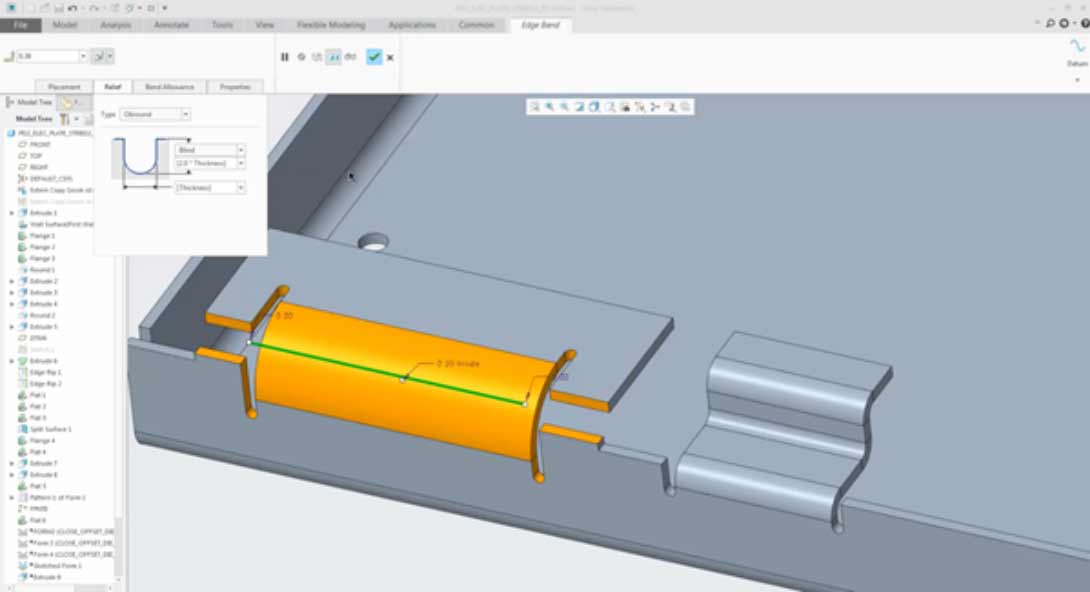
Enhancements to Geometry Manipulation: accessibility to side 2 directly from graphics window when you right-click on a feature without navigating to the dashboard each time; the extrude and revolve tools allow you to specify negative direction values to invert materials for offset geometry; extrude is added to offset to eliminate the step of creating intermediate construction features.
PTC Creo 5.0 includes Topology Optimization, Additive/Subtractive Manufacturing for metal 3D printing, Mold Machining, Flow Analysis, Multi-CAD Collaboration, and improved enhancements with geometry sketch regions, subdivisional modeling, surfacing, sheet metal tools, and volume helical sweeps.
Read more about the newest release in our blog called, “What’s New in Creo 5.0?” or download the data sheet here.
Creo Software – Technology of the Future
When you purchase PTC Creo Software, you have the power to publish, share, and create augmented reality experiences right inside of your 3D CAD models. This allows you to add value to your customer experience because they can now visualize your design with AR.
With Creo Parametric, you also have the power of simulating digital twins within your CAD models to collect real-time data from sensors on a physical product. You can reduce downtime while using this data to find performance issues and schedule predictive maintenance.
As the physical and digital worlds converge, digital transformation starting with the right CAD software is more relevant than ever. PTC Creo software eliminates barriers to innovation and is a solution for product development challenges.
Download a free 30-day trial of PTC Creo to see for yourself how the right CAD software gives you the tools you need to design above and beyond anything you’ve ever imagined.


